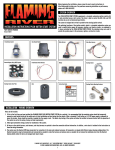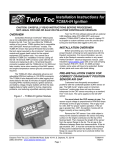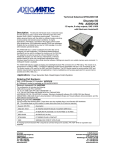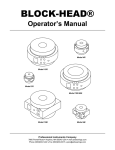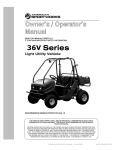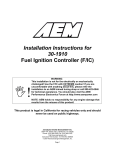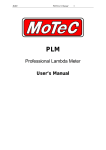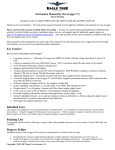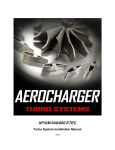Download Redline Gauge User Manual - Cutler`s Performance Center
Transcript
CPC/Redline Gauges Display / RSM User’s Manual Redline Gauges UM001 Rev. 2 28 June 2011 Table of Contents 1. WELCOME ……………….…………………………………………………………………………………………………………………… 2. FEATURES ………………………………………………….…………………………………………………………………………………. 2.1. Sensor Types and Interfaces ………………………………………………………………………………………………….. 2.2. Standard Features …………………………………………………………………………………………………………………. 3. GETTING STARTED……………………………..…………………………………………………………………………………………. 3.1. Installation…………………………….………………………………………………………………………………………………. 3.1.1. RSM……………………………………..……………………………………………………………………………………………… 3.1.2. Display Module……………….………………………………………………………………………………………………….. 3.1.3. Thermocouples…………….…………………………………………………………………………………………………….. 3.1.4. Pressure Connections …….…………………………………………………………………………………………………… 3.1.5. Pulse/Tachometer Connections ……….…………………………………………………………………………………. 3.1.6. 0-5 Volt Connection………………….…………………………………………………………………………………………. 3.1.7. LSU 4.2 Wide Band Connection (Optional)………..………………………………………………………………… QUICK START AND REFERENCE ………………………..…………………………………………………………………….…….. 4. OPERATION …………………………………………..……………………………………………………………………………………… 4.1. Normal Operation………..………………………………………………………………………………………………………… 4.1.1. Warning Lamp…………..………………………………………………………………………………………………………… 4.2. Min/Max Recall ……………………………………………………………………………………………………………………… 4.3. Recording…………………..………………………………………………………………………………………………………….. 4.3.1. Record Trigger (RPM)………………………………………………………………………………………………………….. 4.4. Playback ………………………………..………………………………………………………………………………………………. 5. SETTINGS ……………………………………………………………………………………………………………………………………… 5.1. Default Power-On Screen………..…………………………………………………………………………………………….. 5.2. Record Trigger Settings …………..…………………………………………………………………………………………….. 5.3. Backlight Settings…………………………………………………………………………………………………………………… 5.3.1. Backlight Color…………………….………………………………………………………………………………………………. 5.3.2. Backlight Intensity ………………………………………………………………………………………………………………. 5.4. Units - Celsius/Fahrenheit ……………………………………………………………………………………………………… 5.5. Calibration …………………………………………………………………………………………………………………………….. 5.6. Restoring Factory Settings “Master Clear” ……….……………………………………………………………………. 5.7. Individual Sensor Setup …………………………………………………………………………………………………………. 5.7.1. Selecting Sensor Setup ……………………………………………………………………………………………………….. 5.7.2. Enable/Disable Sensor Measurements ……………………………………………………………………………….. 5.7.3. Setting Lower/Upper Warning Limits………………………………………………………………………………….. 5.7.4. RPM Pulse Count ………………………………………………………………………………………………………………… 5.7.5. MPH Setup …………………………………………………………………………………………………………………………. 6. CARE AND MAINTENANCE…………………………..……………………………………………………………………………….. 7. WARRANTY………………………………………………..…………………………………………………………………………………. 8. FREQUENTLY ASKED QUESTIONS AND ANSWERS …………….…………………………………………………………… 9. GLOSSARY…………………………………………………………………………………………………………………………………….. 10. GAUGE ABBREBIATIONS………………………..……………………………………………………………………………………… 11. NOTES…………..……………………………………….……………………………………………………………………………………… 12. OPTIONAL ACCESSORIES…………………………………………………………………………....................................... 1 of 16 2 2 2 2 3 3 3 4 4 4 4 5 5 5 7 7 8 8 8 8 9 9 9 9 9 10 10 10 10 10 11 11 11 11 11 12 12 13 13 15 15 16 16 Redline Gauges UM001 Rev. 2 28 June 2011 1. WELCOME Congratulations on the purchase of your CPC/Redline Gauge Display/RSM module. This is simply the highest quality gauge made. If you like it, tell your friends. If you have problems, call us at CPC so we can help you adjust it to get the maximum performance from this gauge. Our DNA makeup of racing allows us to understand and manufacture exactly what you need and expect from a gauge. Our gauge features a rugged, reliable, accurate, large, and easy to read screen, large buttons, and ease of operation. 2. FEATURES 2.1. Sensor Types and Interfaces The Display/RSM combination provides an extensive variety of supported sensors and interfaces: • • • • • • Four (4) Type-K thermocouple Temperature inputs from -99 to + 1999 Fahrenheit or -99 to +1372 Celsius including Exhaust Gauge Temperature (EGT) measurements Three (3) pulse inputs for RPM MPH display – Via one pulse user selectable pulse input with distance calibration Three (3) pressure inputs (-100 to +100 PSI) One (1) 0-5V input. Can be displayed in raw volts but is also pre-programmed for use with the Uego AFR 0-5V output for direct display of AFR Optional interface for a Bosch (T) LSU 4.2 wide band AFR sensor 2.2. Standard Features • • • • • • • • • • • Twenty-five (25) seconds of data recording and playback Supports a user preset record trigger RPM Backlight with adjustable color and brightness Warning lamp indication alerts operator when a measured value exceeds user limits Programmable warning limits (upper and lower) for all sensor inputs Displays temperature in Fahrenheit or Celsius (user selectable) User settable start up screen displays preferred measurements when powered-on Calibration for pressure sensors and MPH Individual sensor enable/disable minimizes displayed readings to only those sensors that are used or desired Mechanism to reset gauge to factory settings Built-in test 2 of 16 Redline Gauges UM001 Rev. 2 28 June 2011 3. GETTING STARTED 3.1. Installation Figure 1 below provides the RSM sensor connections, pin locations and basic connectivity. Figure 1: RSM Pin-out And Wiring 3.1.1. RSM The Remote Sensor Module (RSM) is designed to be mounted remotely from the Display module to eliminate the need to route the large number of wires and hoses back to the actual display gauge. The RSM can be mounted in any convenient location close to the sensors. Avoid excessively hot locations and prevent routing sensor wiring/connections near spark plug wires. Also make sure that the mounting location will protect the vent hose from getting water or dirt in it. The vent hose must be facing down to prevent water, dirt, or moisture from gravity feeding down the vent hose. 3 of 16 Redline Gauges UM001 Rev. 2 28 June 2011 3.1.2. Display Module The display module is designed for a handlebar mount or flush mount. There are four (4) taped holes using 6-32 standard thread mounting holes in the back of the enclosure to mount the gauge. The pig tail wire harness is routed back to the RSM into a four (4) prong water resistant connector. 3.1.3. Thermocouples Thermocouple sensors (probes) that have an “open tip” design are for measuring exhaust temperature only. CPC/Redline generic recommendations for thermocouple placement when used in exhaust systems are 100 mm (approximately 4 inches) from face of exhaust side of piston to center line of probe when used on a 2 cycle engine using a two cylinder “Y Pipe” manifold. Use 178 mm (approximately 7 inches) when installing the sensors in a single, twin or triple expansion pipe exhaust system. We currently do not have measurement recommendations for any 4 cycle engines. Thermocouple sensors that have a closed tip are for measuring water temperature. 3.1.4. Pressure Connections The CPC/Redline gauge is designed to read three (3) pressures. The most common pressures measured are Boost Pressure, Fuel Pressure and Oil pressure. The measurement of the pressure can be utilized by connecting a high quality 1/8 (.125) inch inside diameter hose to the stainless steel hose barbs located on the Remote Sensor Module (RSM). Pressure #1 is displayed as PSI 1. Pressure #2 is displayed as PSI 2 and pressure #3 is displayed as PSI 3. The hose barbs located on the RSM are in order with PSI 1 being located on top, PSI 2 in the middle and PSI 3 located on the bottom as viewed on the diagram on page 4. 3.1.5. Pulse/Tachometer Connections The CPC/Redline gauge offers three (3) different pulse/tachometer connections. The color codes for the wires are as follows and some of their uses are also listed. RPM 1 is connected to the blue colored wire and it uses a Hall Effect pulse. It’s most common usage is to pick up the signal from the stator to measure engine RPM’s. A Hall Effect sensor can be identified as having 3 wires, Power, Ground, & signal wire. RPM 2 is connected to the green colored wire and it uses a Hall Effect pulse. It’s most common usage is to pick up a 2nd RPM signal from a rotating shaft such as a jack shaft or drive shaft as is use a signal from a magnetic pick device and can be used to measure the RPM of a rotating shaft or can be used to measure MPH. RPM 3 is connected to the violet colored wire and uses a Variable reluctance (VR) or zero crossing pulse and is most often connected to an electrical device that can be used to measure MPH. As opposed to a Hall Effect sensor, a VR sensor has only two (2) wires. 4 of 16 Redline Gauges UM001 Rev. 2 28 June 2011 3.1.6. 0-5 Volt Connection The 0 to 5 volt connection may be used in one of the following ways: 1. To connect to a third-party 0-5 volt sensor output. With the user’s knowledge of what the voltage represents, the user may monitor the corresponding interface. 2. The CPC/Redline display module is preprogrammed to support an AEM Uego AFR wide band sensor. The AEM wiring harness must be modified by installing special wire terminal connectors by CPC in order for the wires to be plugged into the Remote Sensor Module (RSM) connector. There are three (3) wires coming out of the Uego wiring harness; gray which is not used, white and brown. The white wire is plugged into the top position of the 0 to 5 volt input port and the brown wire in the bottom. The position of the white and brown wires must be plugged into the RSM connector as shown in Figure 1 RSM Pin-out And Wiring on page 3. The CPC/Redline gauge use the 0 to 5 volt input from the AEM wiring harness to measure and record the correct AFR reading which will be displayed on the CPC/Redline gauge using the AFR 2 channel. 3.1.7. LSU 4.2 Wide Band Connection (Optional) The CPC/Redline gauge uses an AEM part number 30-2310. This kit includes a wiring harness with inline circuitry to export 0 to 5 volt analog information to the CPC/Redline gauge. It also includes a LSU 4.2 Bosch Wide Band sensor. Replacement sensors can be purchased from CPC or in most automotive part stores. The AEM LSU 4.2 sensor has a limited life and is NOT covered under warranty by AEM or CPC/Redline. QUICK START AND REFERENCE Reference Figure 1 RSM Pin-out And Wiring on page 3 during installation. 1. Mount the Display and the RSM module. 2. Connect power to the red (+) & black (-) wires on the RSM to a DC power supply. The black wire with an eyelet must also be grounded to the chassis. This gauge will run on 8 to 18 volts DC or AC power. 5 of 16 Redline Gauges UM001 Rev. 2 28 June 2011 3. Connect all sensor inputs. See paragraph 5.5, Calibration, on page 10, before connecting hoses to sensors. 4. The top arrow buttons sequence through measurements on the bar-graph. Similarly, the bottom left arrow buttons control the left display readout and the bottom right arrow buttons control the right display readout. 5. The user can activate the following features by pressing and holding the selected button(s) for two (2) seconds. Note, detailed paragraphs are provided for these in Section 5, Settings. • Press and hold BACKLIGHT to change the backlight color. Push the ENTER button to select and save the desired color. • Press and hold BACKLIGHT & SETUP adjust the backlight brightness. Bottom left arrow buttons adjust brightness in 10% steps. Press ENTER when done. • Press and hold MAX RECALL to view Lo and Hi readings. Use the bottom left red arrow buttons to sequence through all sensors. Pressing the ENTER button returns to the normal display and clears the MIN/MAX readings. • Press and hold MAX RECALL & ENTER at the same time to perform a “Master Clear” to return ALL settings back to Factory Default values. • Press and hold PLAYBACK to replay a recording. • Press and hold PLAYBACK & ENTER at the same time to toggle the temperature scale between Fahrenheit and Celsius. • Press and hold RECORD to start recording an event (approximately 25 seconds). • Press and hold RECORD & ENTER at the same time performs a check of the backlight, warning lamp and all LCD segments. Press ENTER to exit. • Press and hold RECORD & PLAYBACK at the same time to save the current display as the preferred power-on default. • Press and hold RECORD & SETUP at the same time to set up the “record trigger settings.” • Press and hold RECORD & MAX RECALL at the same to perform a “Calibrate All” to zero out all pressure sensors. Note: All pressure sensor hoses must be disconnected when performing this function. An optional jumper harness can be purchased from CPC that uses a 9 volt battery to provide power to perform a “Calibrate All” if you want to calibrate the pressure sensors without the engine running. Not following this procedure will result in the gauge “zeroingout” any pressure being applied to the pressure sensors and result in erroneous measurements. 6 of 16 Redline Gauges • UM001 Rev. 2 28 June 2011 Push and hold SETUP button to adjust measurement parameters. Use the lower left red arrow buttons to select the desired sensor then push ENTER. Each sensor must first be enabled or disabled. You are now prompted to adjust Lo & HI warnings limits. The lower left arrow keys are used to decrease or increase the numeric values. The lower right arrow keys are used to advance (or move back) through the numeric digits. Some sensors, such as RPM, and MPH have additional setup/calibration that can be modified following the Lo and Hi limits. Detailed paragraphs are provided for these in Section 5, Settings. 4. OPERATION 4.1. Normal Operation As soon as power is applied to the gauge, it will begin to display measured values. Three (3) different measurements can be displayed simultaneously: one signal on the top bar-graph and one on each of the two 4-digit screens. Each pair of arrow buttons cycles the readout through the available measurements. The measurements displayed at power-on are factory preset for EGT 1, EGT 2 and RPM 1 on the bar graph. This default power-on display can be changed by setting the screen to the desired measurements and then pressing and holding RECORD & PLAYBACK for two (2) seconds. The RSM provides for many different sensor inputs. Not all inputs are typically used in any particular installation. While cycling the screen through the various measurements, only the installed sensors are displayed. The sequence “skips” the sensors that are not installed or “enabled”. See the settings section for the details on how to make the changes for your specific installation. The bar graph software has been programmed to allow the bar graph to read to display a one (1) bar for the following measurements: When measuring PSI, one bar= one psi. When measuring EGT, one bar = 100 degrees. When measuring RPM, one bar = 1000 RPM. 7 of 16 Redline Gauges UM001 Rev. 2 28 June 2011 4.1.1. Warning Lamp The red warning lamp illuminates whenever a measurement for any of the installed sensors falls outside the signal’s lower or upper limit. The limits are factory preset for each sensor type and are user adjustable (see settings). The offending measurement will also “blink”, when displayed on the screen, to assist you in locating the offending measurement. Additionally, the user can utilize the Min/Max Recall mode to view the minimum and maximum measurement for each sensor. 4.2. Min/Max Recall Min/Max Recall mode is activated by holding down the MAX RECALL button for two seconds. The screen displays the “Max”, “LO”, and “HI” icons. The minimum and maximum recorded values are displayed for each sensor. The low value is displayed on the left portion of the LCD and the high value on the right. When entering Min/Max mode, the initial values displayed are for the signal that was on the lower left screen. The lower left “Up” and “Down” arrow buttons cycle through measurements. The displayed values will update as new max or min values are recorded, just like a high water marker. The user exits the Min/Max mode by depressing the ENTER button. 4.3. Recording The gauge holds approximately twenty-five (25) seconds of recorded data. Recording is activated by pressing and holding the RECORD button for two seconds. The word “REC BEG” will briefly blink on the screen to indicate that recording has begun. Additionally, the “R” icons will blink throughout the recording. When the recording completes, the words “REC END” will blink. Recording stores all displayed screen information. If the displayed measurements are changed during the recording, the same change will be observed during playback. Additional recordings overwrite the previous recorded values. Recorded values are not stored when the gauge is powered down. 4.3.1. Record Trigger (RPM) An optional RPM trigger may be used to trigger the actual storage of the twenty-five (25) seconds of data. This allows the operator to cue the recording, however, the gauge will not begin storing data until triggered by reaching a preset RPM. The factory default is an RPM of zero (0) such that storage begins immediately. When a programmed RPM threshold is used, the LCD will blink “CUE RECd” until the trigger RPM is reached. For additional details, see Section 5.2. Record Trigger Settings. As an example, suppose the operator wants the recording to begin storing data when an RPM of 5000 is reached. First, program the Record Trigger settings for the desired RPM input (Tach 1, 2 or 3) and then set the trigger RPM to 5000. Now, when the Record button is pressed and held for two seconds, the screen will first blink “RECd BEG” and then begins to blink “CUE RECd”. Once the RPM reaches 5000, the “CUE RECd” stops blinking and storage begins. 8 of 16 Redline Gauges UM001 Rev. 2 28 June 2011 4.4. Playback You can view the recorded measurements by depressing and holding the PLAYBACK button for two (2) seconds. The words “PLAY BEG” will blink to signify that playback has begun. The recorded screen values will then be played back at a rate of 4Hz. The words “PLAY END” will blink when the playback has reached the end of the recorded values. The playback can be terminated by again holding down the PLAYBACK button for two (2) seconds during the process. 5. SETTINGS 5.1. Default Power-On Screen The default power-on screen display can be easily changed. First, setup all three (3) screens to display the desired power-on measurements. Then, depress and hold the RECORD and PLAYBACK buttons for two (2) seconds. The screen will blink with dashes, “----”, to signify the change. These measurements will now be displayed each time when the gauge is powered-on. This can be changed any time by repeating the same procedure. 5.2. Record Trigger Settings The Record Trigger settings allow the operator to start recording data at a preset RPM value (see Sections 4.3 and 4.3.1 for a full description of record and trigger operation). To modify the Record Trigger settings, press and hold the SETUP and RECORD buttons simultaneously for two (2) seconds. There are two values for the user to enter: 1) Select one of the three RPM inputs as the trigger input 2) Enter the RPM trigger threshold First, the screen will display “TACH x”, where x is 1, 2 or 3. This is the particular RPM input that will be used for the trigger. The value is changed with the bottom left arrow buttons. Press the Enter button when done. Next, the screen will display the actual RPM used for the trigger. Again, the values are changed with the lower left arrow buttons. The bottom right arrow buttons (SETUP and ENTER) are used to advance through the digits. These values are saved after advancing through the last digit. These settings will continue to be used in all future recordings, even after the gauge is power cycled. To make the recording trigger immediately after pressing the RECORD button, set the RPM threshold to zero (“0000”) RPM. This is also the factory default value. 5.3. Backlight Settings The display incorporates a state of the art backlight capable of providing multiple colors and intensity. 9 of 16 Redline Gauges UM001 Rev. 2 28 June 2011 5.3.1 Backlight Color The color of the backlight can be changed by pressing and holding the BACKLIGHT button for two (2) seconds. The color of the backlight will begin to cycle through the various colors. Depress the ENTER button when the desired color is displayed. This color will be maintained or “Locked” for future use even after the gauge is powered down. 5.3.2. Backlight Intensity The intensity or brightness of the backlight can be changed by holding the SETUP and BACKLIGHT buttons for two (2) seconds. The screen will display “ILLU” on the left (for Illumination) and the current brightness, in percent, will be blinking on the right. Use the bottom left arrow keys to increase or decrease the brightness in 10% increments. Press the ENTER button after reaching the desired brightness. The brightness value is saved and will continue to be used after the gauge is powered down/up. If no buttons are pressed for 30 seconds, then the setting times-out and returns to normal display without saving any adjustments. 5.4. Units - Celsius/Fahrenheit The display can be configured to display temperature in either Fahrenheit (factory default) or Celsius. To change units, depress and hold the PLAYBACK and ENTER buttons for two seconds. The new scale will be displayed momentarily. 5.5. Calibration The sensitivity of the pressure sensors often results in a small offset being measured and displayed. If this is observed (i.e., non-zero value with no pressure applied), then the values can be calibrated or zeroed by pressing and holding the RECORD and MAX RECALL buttons for two (2) seconds. The screen will blink dashes (“----”) to signify the operation. The user should use caution when using this mode. Ensure that no pressure is actually applied to any of the pressure sensors when activated. If any pressure is applied to a sensor, it will be zeroed out and all future measurements will be displayed with an error. Note that individual sensors can be calibrated during the process of making settings for that particular sensor. 5.6. Restoring Factory Settings “Master Clear” The gauge can be reset to factory settings (Master Clear) by depressing and holding the MAX RECALL and ENTER buttons for two (2) seconds. The screen will display “CLr” and the word “NO” will be blinking by default to prevent accidental activation. To actually reset, change the “NO” to “YES” with either of the bottom left arrow keys. With “YES” flashing, press the ENTER key. If this mode was invoked by accident, simply press the ENTER button while “NO” is blinking and no action will be taken. Note: When performing a “Master Clear” procedure, all display settings will be programmed back to factory default settings. Pressure sensors may require calibration after performing this step. 10 of 16 Redline Gauges UM001 Rev. 2 28 June 2011 5.7. Individual Sensor Setup Sensor settings can be modified by holding down the SETUP button for two (2) seconds. Each sensor can be individually programmed for the following settings: • Enable/Disable (turn on or off the sensor from reading on the display) Sensor Measurements • Lower and Upper Warning Limits • Pulses Per Revolution (RPM Only) • Selectable Tach Input (MPH Only) • Calibration/Zero (MPH and Pressure Sensors Only) 5.7.1. Selecting Sensor Setup After pressing and holding the SETUP button for two (2) seconds, the screen will begin flashing the currently selected sensor indication (i.e., “EGT 1”). Additionally, the sensors low and high warning limits are displayed to aid selection and provide a quick review of existing warning limits. The bottom left arrow buttons are used to sequence through the available sensors. All possible sensors can be sequenced through. This allows previously disabled sensors to be enabled. When the desired sensor is selected, depress the ENTER button to begin modifying the sensors settings. 5.7.2. Enable/Disable Sensor Measurements Immediately following the selection of a specific sensor, the screen will display “Enbl ON” or “Enbl OFF” depending on whether the selected sensor is currently enabled or disabled. The blinking “ON” or “OFF” can be changed by pressing either of the lower left arrow buttons. To complete the Enable/Disable sequence, press the ENTER button. If the sensor is disabled, the screen will return to normal display. Note that disabled sensors are not available for display during normal operation. By disabling unused sensors, the user can limit which sensors may be sequenced through/displayed during normal operation. 5.7.3. Setting Lower/Upper Warning Limits During the sensor settings, the lower and upper warning limit values are displayed following the enabling of the sensor. The lower warning limit is displayed on the left and the upper limit on the right. A measurement exceeding either of these limits results in the gauge illuminating the warning light. The values are changed by decrementing/incrementing each digit with the lower left arrow buttons. Advancing through the digits is accomplished by pressing the lower right arrow/ENTER button. If a mistake is made, the cursor can be moved back by depressing the lower right arrow/SETUP button. Advancing past the last digit accepts the settings. 5.7.4. RPM Pulse Count For the Tack inputs (RPM 1 thru RPM 3) the user is prompted for a pulse count after setting the lower and upper limits. This pulse count represents the number of “teeth” or pulses that are counted in one full revolution of the physical rotating shaft. This number is required for the gauge to correctly compute 11 of 16 Redline Gauges UM001 Rev. 2 28 June 2011 revolutions Per Minute (RPM). After setting the lower and upper limits, the user is prompted with “PULS” and the existing programmed value. The value is incremented/decremented with the lower left red arrow buttons. After entering the correct value, select the ENTER button to accept the value. 5.7.5. MPH Setup To set up your MPH on your CPC/Redline gauge you will need to perform the following set up and calibration procedure. First, mark off 660 feet with a long tape measure. Next, position the snowmobile or ATV at the starting line. Press and hold the SETUP button for two (2) seconds. Use the bottom left arrow buttons to scroll to MPH, and then press ENTER. Make sure that the MPH is turned on by checking to see if the screen displays “Enbl ON”. If it is already on press ENTER. If the screen displays “Enbl OFF” then change to “Enbl ON” with either of the bottom left arrow buttons and then press ENTER. Next set MPH Minimum (LO) and Maximum (HI) warning limits according to your personal preference, then press ENTER. Use the bottom left arrow buttons to change the limit values. The bottom right arrow buttons are used to move the cursor left and right. After setting the LO & HI limits, pick which tachometer (RPM input) input is connected to the jackshaft or driveshaft sensor. Note: Use Tachometer RPM 2 (which reads Hall Effect inputs and is a green color wire going into the RSM connector) if the sensor is a three wire input or use Tachometer RPM 3 (which reads Variable Reluctance inputs and is a violet colored wire going into the RSM connector) if the sensor is a two wire input. Set the CAL to “YES” using the bottom left arrow buttons, and then press ENTER. At this point the gauge will say “PULS” to indicate it is now counting pulses for calibration. Finally drive the snowmobile or ATV to the 660 foot finish line while being careful not to spin the track or tires, and then press ENTER. While driving, you will see the pulse counter increasing. Your snowmobile or ATV is now calibrated to display MPH. 6. CARE AND MAINTENANCE To get the most out of your gauge, there are several items you must be aware of: 1. Do not leave the gauge exposed to long periods of sunlight. Sunlight ultra violet rays can damage the gauge over lay and fade the anodized finish of the aluminum gauge. 2. Do not expose or clean the gauge with gasoline or other harsh solvents. Cleaning should be done with a soft cloth with mild soap and warm water. NEVER use a steam cleaner or high pressure washer to wash the gauge or any of its components. Using high pressure water can peel off the gauge over lay off and damage the gauge. Never use a dry cloth to remove dirt from the gauge over lay as it will scratch the lens. 3. Never submerge the display gauge or Remote Sensor Module (RSM) in water. Occasional snow or rain on the outside of the display will not hurt the gauge. The RSM however should be covered to prevent snow, water or dirt to enter the vent hose. 12 of 16 Redline Gauges UM001 Rev. 2 28 June 2011 7. WARRANTY CPC/Redline warrants to the consumer that all high performance gauges/products will be free from defects in material and workmanship for a period of twelve (12) months from date of the original purchase. Gauges/products that fail within the 12 month warranty period will be repaired or replaced at CPC/Redline’s option. This warranty is limited to the repair or replacement of the CPC/Redline part. In no event shall this warranty exceed the original purchase price of the gauge/product, nor shall CPC/Redline be responsible for special, incidental, or consequential damages or cost incurred due to the failure of this product(s). All thermocouple sensors will be covered under warranty for six (6) months. The Bosch LSU 4.2 or 4.9 sensors have a limited life and is not warranted under any condition or time period. Warranty claims to CPC/Redline must be transportation prepaid and accompanied with dated proof of purchase. This warranty applies only to the original purchaser of the gauge/products and is non-transferable. All implied warranties shall be limited in duration to the said 12 month warranty period. Improper use or installation, accident, abuse, water damage, sun (UV) damage, dirt damage or unauthorized repairs or alterations voids this warranty. CPC/Redline disclaims any liability for consequential damages due to breach of any written or implied warranty on any and all gauges/products. For Technical Service please contact Cutler’s Performance Center (CPC), 271 North State Street, Orem, Utah 84057, 801-224-5005, from 9:30 to 6:00 MST. 8. FREQUENTLY ASKED QUESTIONS AND ANSWERS Question: Will the CPC/Redline gauge run on AC or DC voltage and does it need a voltage regulator? Answer: This CPC gauge will run on AC or DC current. It has a built in voltage regulator to protect it up to 18 volts. This gauge is also fuse protected. Question: On occasion, my CPC/Redline gauge turns off at an idle. What causes it and how do I correct the problem? Answer: Your CPC/Redline gauge is not defective. It will shut off anytime the voltage drops below 8 volts AC or DC. This problem can be corrected by feeding the gauge a steady voltage of 8 plus volts. This can be corrected by turning up the idle of your ATV/Snowmobile/RV until the stator produces 8 volts or check the condition of your battery if one is used. If the voltage (AC or DC) drops below 8 volts, the gauge will turn off and any data received into the gauge will also be lost. Question: Is my CPC/Redline gauge waterproof? Answer: Your CPC/Redline gauge is water resistant, not waterproof. Water resistance means that the gauge enclosure will resist rain and snow. We have tested the gauge underwater and it works great. The problem is that the attached RSM requires a vent line and water must not be introduced into the gauge via this vent. Nor should water or dirt enter into the three (3) 13 of 16 Redline Gauges UM001 Rev. 2 28 June 2011 pressure sensors if they are not used. Unused pressure ports must be capped off to prevent contamination of any kind entering these hose barb inputs. The outside of the RSM is also water resistant. Question: What are the most common ways owners damage their gauges. Answer: There are many ways to damage the gauge and RSM. The most common would be to use a high pressure washer and peel off the overlay membrane off the gauge enclosure at a car wash. Submersion in water of the RSM could allow water to enter into the vent hose. Another way would be sun damage by allowing the gauge to be exposed to weeks or months of direct sunlight. Avoid mounting the RSM or any wires or pressure hoses near a hot engine or exhaust pipe. Extreme heat (above 180 degrees Fahrenheit) will damage your gauge/RSM. Question: Can I perform a “Master Clear” or a “Calibrate All” function without the engine running? Answer: You can only perform those functions if you have power go the RSM and display gauge. If a running engine is the only source of power, you can purchase an optional jumper wiring harness which uses a 9 volt battery to program the gauge. A new battery will last about 20 to 30 minutes of program time. Remember that the hoses going to the RSM pressure sensors must be disconnected before performing these functions or an error will result in the zeroing out process. Question: When installing thermocouple probes in an exhaust pipe, how far do you place the probe tip into the pipe and how tight do you torque the nut on the bung to avoid damaging the probe? Answer: The thermocouple probe should be inserted into the exhaust pipe 3/8 (.375) of an inch. When using two or more probes, make sure that they are inserted the same distance if not your readings could vary up to 100 degrees Fahrenheit different from one another. When tightening the nut on the bung for the first time, tighten the nut hand tight, then using a ½ inch wrench, tighten the nut exactly ½ turn. Any time when performing maintenance on the exhaust and the probe is reused, just snug the nut approximately 8 pounds of torque. Note, over tightening the nut will cause damage to the probe and could cause the probe to break off and will void warranty! Question: If a connector or a wire gets damaged, how do I disassemble the wires from the connector? Answer: The best solution is to send the damaged parts to CPC for repair. If you need instructions to separate the connector from the wires for any reason go to http://www.laddinc.com/customer-resources/how-to-instructions/dt-series.html 14 of 16 Redline Gauges UM001 Rev. 2 28 June 2011 9. GLOSSARY AFR EGT HES LCD MPH PSI RPM TACH VR ……………………. ……………………. ……………………. ……………………. ……………………. ……………………. ……………………. ……………………. ……………………. AIR FUEL RATIO EXHAUST GAS TEMPERATURE HALL-EFFECT SENSOR LIQUID CRYSTAL DISPLAY MILES PER HOUR PRESSURE PER SQUARE INCH REVOLUTIONS PER MINUTE TACHOMETER VARIABLE RELUCTANCE 10. GAUGE ABBREBIATIONS The following abbreviations are used by the display during operation, user setup, and various alerts: ---- ………… All dashes: indicates no values for the specified measurement are being transmitted from the RSM to the display. CAL ………… Calibrate: prompt asking operator if they want to calibrate the sensor. Used when setting MPH and PSI settings. Clr ………… Clear: query, asking operator to verify a Factory Reset. CUE RECd ………… Cue Recording: recording is activated and waiting on RPM trigger. When the RPM exceeds this user programmed value, the recording begins to save the values on the screen. Enbl on / Enbl OFF ………… Enable On or Enable Off: displayed as first step of each sensor setup to enable or disable that sensor from being displayed. Err ………… Error: the displayed measurement is out of the measurable range indicating a likely sensor failure or connection problem. ILLU ………… Illumination: displayed during brightness adjustment. PLAY BEG ………… Playback Begin PLAY End ………… Playback End PULS ………… Pulse: displaying either 1) pulse count during MPH calibrating or 2) prompting operator to enter number of pulses per revolution during setup of an RPM input. RECd BEG ………… Recording Begin RECd End ………… Recording End: indicates Recording completed. SEL COLr ………… Select Color 15 of 16 Redline Gauges UM001 Rev. 2 28 June 2011 11. NOTES #1. (A). 2010-2011 Arctic Cat M8 uses RPM2 (Hall Effect style sensor) to allow the Speedometer to operate. The green wire from the RSM goes to the white/orange wire going into the pick up by the disc brake on the RH side of the snowmobile. The pulse count on a 2009-2011 Arctic Cat M8 is 1320 pulses to make the MPH read correctly. On Sno-Pro models, the factory speedometer feature on the gauge will read erratic due to electrical interference. The input wires going to the factory speedometer input should be disconnected at the wiring connector at the brake disc location when using the MPH function of the CPC/Redline gauge. (B). Also when wiring the RPM 1 to achieve a Tachometer signal, the RSM (which will give you the correct sensor wire for using the tachometer), connects to the blue wire coming out of the RSM (RPM 1) to the purple wire at the connector where the hood wiring harness connects to the main wiring harness. The purple wire is the 3rd wire from the end on the top row of wires. 12. OPTIONAL ACCESSORIES Part # CP-30-2310 UEGO Inline Wideband AFR Controller GO Inline Part # CP-30-2001 UEGO Inline Wideband AFR Replacement Sensor Part # CP-30-BUNG UEGO SST Manifold Bung Part # CP-001-6011 CPC Redline Exposed Tip Thermocouple (EGT Sensor) Part # CP-001-6012 CPC Redline Closed Tip Thermocouple (Water Sensor) Part # CP-001-6013 CPC Redline Weld-On Bung 16 of 16 Redline Gauges UM001 Rev. 2 28 June 2011 Part # CP-001-6014 CPC Redline 1/8 NPT Compression Fitting Part # CP-000-005 Billet Water Coupler 7/8 Part # CP-000-006 Billet Water Coupler 1” Part # CP-30-9VH CPC Redline Guage 9 Volt Harness Part # CP-30-FUSE CPC Redline Slow Blow Replacement Fuse Part # CP-30-HOSE 1/8" ID Pressure Hose (Sold Per Foot) Part # CP-30-5FT CPC Redline 5 Foot Harness Extension Part # CP-001-6015 CPC Redline Arctic cat M / Pro Climb gauge mount (Handlebar mounted. Will only work on models with adjustable steering post) 17 of 16


















